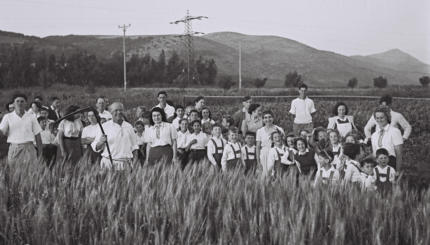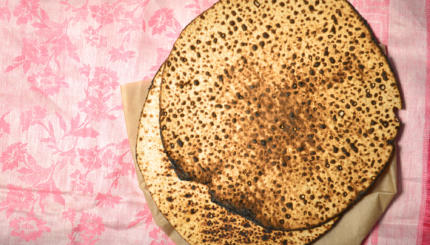Reprinted with permission from the Schechter Institute of Jewish Studies in Jerusalem
Modern Jewish educators frequently use drama as an educational tool in order to bring a biblical or talmudic story to life, or to get a child more actively involved in the subject under discussion.
Much of the Pesach seder is also geared toward children, in order to fulfill the mitzvah of “v’higadita l’vinkha“–“and you shall tell your children” (Exodus 13:8). That is why the Talmud instructs us to distribute parched grain and nuts to children at the seder, so that they should ask questions and not fall asleep (Pesahim 109a). Therefore, it should come as no surprise that three sets of Pesach customs use drama in order to arouse the interest of children and bring the Exodus to life.
“The Wandering Jew”
 There is a widespread custom among Sephardic and Oriental Jews, according to which various members of the family at various points in the seder dress up as if they had just left Egypt. Other family members ask formal questions and “the wandering Jew” explains that he has left Egypt and is on his way to Jerusalem. These ceremonies differ in various details; what follows is a representative selection:
There is a widespread custom among Sephardic and Oriental Jews, according to which various members of the family at various points in the seder dress up as if they had just left Egypt. Other family members ask formal questions and “the wandering Jew” explains that he has left Egypt and is on his way to Jerusalem. These ceremonies differ in various details; what follows is a representative selection:
With your help, My Jewish Learning can provide endless opportunities for learning, connection and discovery.
1) Benjamin II (Yisrael ben Yosef Benjamin) described such a ceremony “in Asia” ca. 1853. They dress up a young man in “kley golah” (Ezekiel 12:3: “gear for exile”) and before the recitation of the Haggadah, he appears before the participants with his staff in hand and his satchel on his shoulder. The father asks him:
“From where do you come, O pilgrim?”
“From the land of Egypt,” says the lad.
“Did you go out to freedom from the bondage of Egypt?”
“Yes indeed,” replies the lad, “and now I am a free man.”
“Where are you going?”
“I am going to Jerusalem,” he replies.
With great joy the participants begin to tell the story of the Exodus.
2) R. Ya’akov Sapir described the custom in San’a, Yemen in 1858:
The seder is observed as is the custom among all Jews. One of the members of the family takes a matzah and ties it in a scarf on his shoulder and walks around the house. The others ask him: “Why are you doing this?” And he replies: “So did our ancestors when they left Egypt in haste.”
3) The Jews of Morroco had the following custom:
After reading the Haggadah, all of the men put a stick with a bundle on their shoulders, and they leave the house in haste, running and shouting: “So did our ancestors leave Egypt, ‘their kneading bowls wrapped in their cloaks upon their shoulders’ ” (Exodus 12:34).
4) Nahum Slouschz describes a similar custom in Libya before the seder and concludes:
“This custom is widespread in almost all oriental lands, and in every country there is a different nusah [melody].” Indeed, this custom was observed in the Caucasus, Iraq, Kurdistan, Djerba, Syria, and among the Sephardic Jews of Seattle.
However, surprisingly enough, this custom is first mentioned in Germany 650 years before Benjamin II described it in Asia, and it is documented in Poland in the 16th century and in Germany and Hungary in the 20th.
Rabbi Asher of Lunel states in his Sefer Minhagot written ca. 1210 in Provence:
I heard that in Allemagne (Germany), after eating karpas [green vegetable], they uproot the table and take the matzot and wrap them in coverings and bear them on their shoulders and walk to the corners of the house, and then they return to their places and recite the Haggadah.
R. Shlomo Luria (Lublin, 1510-1573) devoted one of his responsa (no. 88) to the laws of the seder:
After the meal he [the person leading the seder] takes out the hidden treasure, i.e. the afikoman as is, wrapped in a cover, and he drapes it behind him and he walks approximately four cubits in the house and says: “So did our ancestors go with ‘their kneading bowls wrapped in their cloaks.’ “
In 1951, Prof. Alexander Scheiber documented similar customs among his students at the Rabbinical Seminary in Budapest, who came from the Hungarian towns of Szatmar, Zemplen, Vatz, Tisfolgar, and Puntok. In the latter town, when they reached Yahatz [breaking the middle matzah], the father would wrap the afikoman in a scarf, put it on his shoulder, stand up, and say to his family in Yiddish: “geimir, geimir!” (Let us go! Let us go!).
This custom has survived among German Jews until today. When I lectured on this topic in Jerusalem before Pesach in 1991, a woman told me that in Karlsruhe, in southern Germany, her father would put the matzah wrapped in the sedertuch (white matzah cover) on his shoulder and say: “So sind die Kinder Jisroel aus Mizraim gegangen, so war es” (Thus did the Children of Israel leave Egypt, so it was).
“Shfokh Hamatkha”–“Pour Out Thy Wrath”
 Quite a few scholars have already detailed the history of these verses, which are recited after Birkat Hamazon [Grace After Meals] and before Hallel.
Quite a few scholars have already detailed the history of these verses, which are recited after Birkat Hamazon [Grace After Meals] and before Hallel.
The apostate Antonius Margaritha (born ca. 1490) relates in his book Der Gantz Judisch Glaub, published in Augsberg in 1530, that when Jews open the door for shfokh, someone in costume enters the room quickly, as if he is Elijah himself coming to announce the coming of the Messiah.
R. Yosef Yuspa Hahn (1570-1637) mentioned above says “how good is the custom that they do something in memory of the Messiah. One falls into the entranceway at the beginning of shfokh to show during the night of our first redemption our strong belief in our final redemption.”
Apparently, someone would pretend to be Elijah coming through the door, and Rabbi Hahn thought that this was a wonderful custom. But R. Yair Hayyim Bachrach (1638-1701) was opposed to this custom: “But what the servants and maids are accustomed to make the figure of a man and the like, something frightening when the door is opened–this is only licentiousness and derision.”
This custom clearly fits in with the Cup of Elijah and other Elijah customs at the seder. It may have been another tactic to keep the children awake. On the other hand, this may be a misunderstanding of the “wandering Jew” skit which took place, as we have seen, at many different points in the seder.
The Parting of the Reed Sea
The last customs we shall discuss take place not at the seder, but on the seventh night of Pesach. According to the Sages, our ancestors crossed Yam Suf, the Reed Sea, on the seventh night of Pesach. Various groups of Jews have developed ways of reenacting the splitting of the Reed Sea.
The Gerer Hasidim gather in the shtibl [small synagogue] on the seventh night of Pesach; they drink wine and they dance. They then pour a barrel of water on the floor, lift up their long cloaks, and “cross the sea” while declaring the towns which are located on the way to Gur [the city they were from]. At each “town” they drink l’chaim and then continue to Gur. When they “reach” Gur after “crossing the sea”, they once again drink l’chaim and thank God for reaching their destination.
A similar custom from Reishe, Galicia, in the 1890s is described by my great uncle Herman Leder (1890-1973) in his Yiddish memoir Reisher Yidn:
“There were several other Jews who were devoted to certain mitzvot more than to others. One of them, was Reb Ephraim Tzibele.
“Until today I don’t know why he was called “Tzibele” (onion). As a child, I frequently asked, but no one knew the answer. He lived on Melamdim Street. He was an extremely frum (pious) Jew who sat day and night studying and praying. His special distinction lay in the fact that he demonstrated with his children how the Jews crossed the Reed Sea after they were redeemed from Egypt.
“He lived in a little wooden house which consisted of one room for himself and his family. One heard little about him all year long and one took little interest in him. But when the seventh day of Pesah arrived, everyone talked about Reb Ephraim Tzibele, because on that night he used to lead his wife and children through the Sea of Reeds.
“Since there was no sea in his house, he created a miniature ‘sea.’ He turned over the keg of water which stood by the door and flooded the room with water. He then took his family and crossed the ‘sea’ with them, from one side of the room to the other. Many people used to gather there that night to witness the demonstration.”
Similar customs were observed in at least six Hungarian towns until the Holocaust.
In Jerusalem, on the other hand, the Hasidim of Reb Arele (1894-1947) in Meah Shearim recreate the splitting of the Reed Sea in a different fashion. The disciples act as the sea and the rebbe represents the Children of Israel. The rebbe passes through them and the students slowly part, allowing him to pass through….
In conclusion, we see that our ancestors used drama as a teaching tool at the Pesah seder. We hope that these customs will enrich the sedarim of those who decide to adopt them, as they have enriched the sedarim of many Jews throughout the generations.
Birkat Hamazon
Pronounced: beer-KAHT hah-mah-ZONE, Origin: Hebrew, Grace After Meals, the blessing thanking God for the food.
l’chaim
Pronounced: luh-KHYME (rhymes with time), Origin: Hebrew, to life, often said as a toast before drinking alcohol.
mitzvah
Pronounced: MITZ-vuh or meetz-VAH, Origin: Hebrew, commandment, also used to mean good deed.
Pesach
Pronounced: PAY-sakh, also PEH-sakh. Origin: Hebrew, the holiday of Passover.
seder
Pronounced: SAY-der, Origin: Hebrew, literally "order"; usually used to describe the ceremonial meal and telling of the Passover story on the first two nights of Passover. (In Israel, Jews have a seder only on the first night of Passover.)
Sephardic
Pronounced: seh-FAR-dik, Origin: Hebrew, describing Jews descending from the Jews of Spain.
Talmud
Pronounced: TALL-mud, Origin: Hebrew, the set of teachings and commentaries on the Torah that form the basis for Jewish law. Comprised of the Mishnah and the Gemara, it contains the opinions of thousands of rabbis from different periods in Jewish history.


